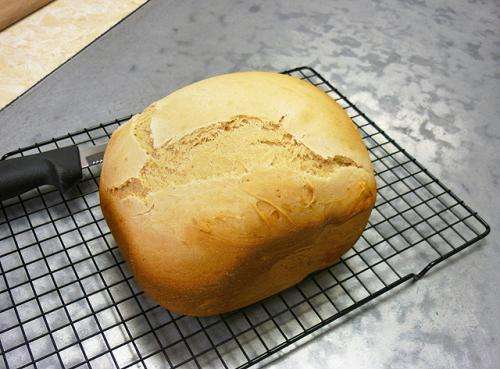Scientists develop new way to make food ingredient from rice bran oil

If you enjoy cooking with a variety of different oils, you've probably worked with rice bran oil, perhaps for stir-frying or sautéing. A staple at Asian food markets or other specialty or gourmet grocery stores, this mild-flavored oil is high in vitamin E—an advantage that many other well-known cooking oils can't offer. The oil comes from the outer layers of the rice kernel that are removed when the grain is milled and polished to produce white rice.
At the Agricultural Research Service's National Center for Agricultural Utilization Research in Peoria, Illinois, chemist Erica Bakota and colleagues have shown how to extract natural compounds from the oil to make an interesting new food ingredient. Bakota says the product "looks something like a nut butter" and "shows promise for several uses," including as a replacement for some of the butter, margarine, or shortening currently used in popular baked goods.
The product, or "extract," consists primarily of unrefined rice bran oil and rice bran's natural wax, used in confections. It also contains minor amounts of such compounds as vitamin E; plant sterols, including some that are of interest to medical and nutrition researchers because of their potentially health-imparting properties; and gamma-oryzanol, shown to lower levels of "bad" LDL cholesterol in humans.
Unlike some shortenings and margarines, the extract is free of trans fats, which contribute to increased risk of heart disease. Another plus: The extract is shelf-stable: It resists oxidation that could otherwise result in off-flavors and unpleasant odors.
In preliminary experiments, Bakota and co-workers have substituted the extract in place of some of the butter called for in conventional recipes for white bread and granola. Feedback from taste testers (technically speaking, sensory panelists) indicates that the substitutions didn't detract from either the taste or the texture of the bread or granola.
The idea of making a butterlike product from rice bran oil isn't new, nor is the team's choice of solvent (acetone, which is already approved for extracting edible oils). However, Bakota's extraction or fractionation procedure apparently differs from others in that it uses very low temperatures to keep the mixture of acetone and unrefined rice bran oil chilled while the compounds that make up the new extract are separated from the oil.
The result? "The texture and composition of our product are unique," Bakota says.
Bakota and Peoria teammates Michael J. Bowman, Hong-Sik Hwang, Sean X. Liu, Debra L. Palmquist, and Jill K. Winkler-Moser described the research in a 2013 scientific article published in the European Journal of Lipid Science and Technology and also in an article recently accepted for publication in that journal.
ARS is seeking a patent for the extraction procedure, and Bakota, in the meantime, is looking for collaborators interested in exploring applications of the extract. She explains, "We think our product can make the fat profile of many familiar foods much more healthful—and still get high ratings from taste testers."
Provided by Agricultural Research Service




















